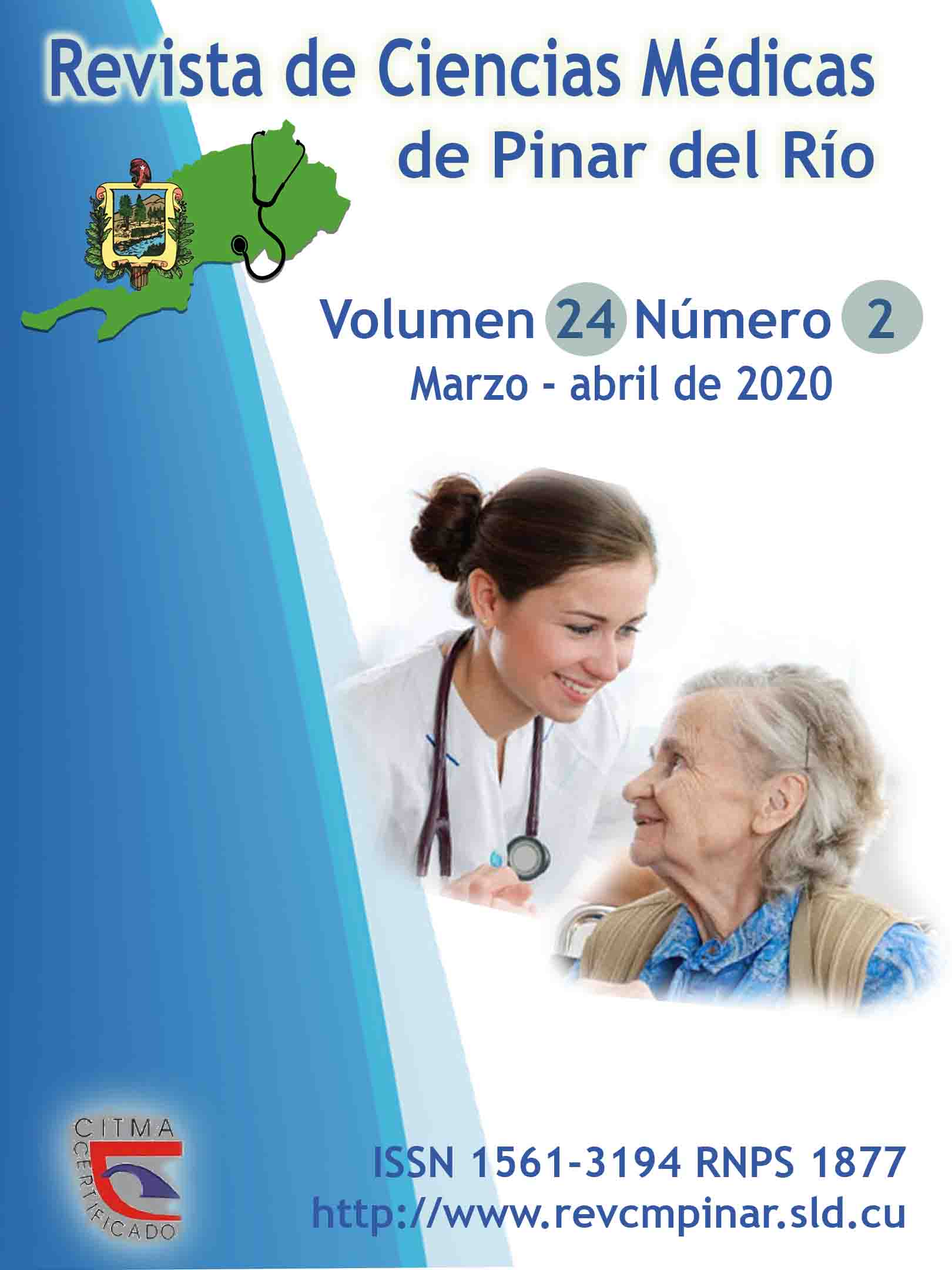Computer system for the evaluation of external quality control in clinical laboratories (PRICECLAB)
Keywords:
INFORMATION, QUALITY, CLINICAL LABORATORY, INFORMATION MANAGEMENT.Abstract
Introduction: Information Technologies favour the quality, safety, efficiency and productivity of health services. Its use in modern clinical laboratories is a current need due to a growing demand for examinations, new services and greater demands in terms of their quality.
Objective: to develop a computer system that contributes to the improvement of the external quality control evaluation process for Clinical Laboratories in Pinar del Río.
method: technological development research that defines the implementation process of a web application based on the information gathered as part of the external quality evaluation of clinical laboratories in units of the provincial health system in Pinar del Río. The technologies used for the design and implementation of the web application are also defined.
Results: the computer system offers laboratories the possibility of completing their Internal Control scheme with an objective estimation of the quality of their measurement procedures. The system allows to estimate the interlaboratory variability, as well as to compare and evaluate methods, in order to demonstrate the performance of the laboratory and to guide on possible causes of error.
Conclusions: the computer system resulting from the research favors decision making, as well as the improvement of quality standards in the process of external control of clinical laboratories through the use of Information Technology and Communications, as part of the country's computerization policy.
Downloads
References
1. García Garcés H, Navarro Aguirre L, López Pérez M, Rodríguez Orizondo M. The Information and Communication Technology in health and medical education. EDUMECENTRO [Internet]. 2014 Abr [citado 12/06/2017]; 6(1): [aprox. 12p.]. Disponible en: http://www.revedumecentro.sld.cu/index.php/edumc/article/view/373/570
2. Rodríguez Díaz A, García González G, Barthelemy Aguiar K. Informatización en el Sistema Nacional de Salud. Enfoques hacia la dirección en salud. INFODIR [Internet]. 2014 [citado 26/02/2020]; (16): [aprox. 0 p.]. Disponible en: http://www.revinfodir.sld.cu/index.php/infodir/article/view/8
3. Pacheco Correa Y, Chiroles Cantera M, Reyes Chirino R, Sisto Díaz A. Digitalización de los anuncios e informes operatorios. Rev Ciencias Médicas [Internet]. 2018 Feb [citado 12/09/2019]; 22(1): [aprox. 7p.]. Disponible en: http://www.revcmpinar.sld.cu/index.php/publicaciones/article/view/3279
4. González Fajardo I, Díaz Padilla D, Rodríguez Rodríguez L, Sanabria Negrín JG. Evaluación externa de la calidad en química clínica en Pinar del Río. Rev Ciencias Médicas [Internet]. 2018 Abr [citado 21/09/2019]; 22(2): [aprox. 10p.]. Disponible en: http://scielo.sld.cu/scielo.php?script=sci_arttext&pid=S1561-31942018000200010&lng=es
5. Chiroles Cantera M, Pacheco Correa Y, Reyes Chirino R, Sisto Díaz A. Implementación de una aplicación web para el módulo servicio quirúrgico de la aplicación Behique. Rev Ciencias Médicas [Internet]. 2017 Dic [citado 12/09/2019]; 21(6): [aprox. 7p.]. Disponible en: http://www.revcmpinar.sld.cu/index.php/publicaciones/article/view/3280
6. Barquero García J. ¿Qué es Laravel? [Internet]. Copyright © Arsys; 2015 [citado 15/09/2015]. Disponible en: https://www.arsys.es/blog/programacion/que-es-laravel/
7. JavaScript. [Internet]. Campus MVP; 2017 [citado 12/09/2019]. Disponible en: https://www.campusmvp.es/recursos/p ost/los-5-mejores-frameworks-dejavascript-en-2017.aspx
8. Burbeck S. Application programming in Smalltalk-80: How to use Model- View-Controller (MVC). [Internet]. 2012 [citado 15/09/2019]. Disponible en: http://www.dgp.toronto.edu/~dwigdor/teaching/csc2524/2012_F/papers/mvc.pdf
9. Rhoads D, Novak S, Pantanowitz L. A review of the current state of digital plate reading of cultures in clinical microbiology. J Pathol Inform [Internet]. 2015 [citado 15/09/2019]; 6: [aprox. 23p.]. Disponible en: https://www.ncbi.nlm.nih.gov/pmc/articles/PMC4466785/
10. Llipe M, Adela D. Sistema web de registro y seguimiento de pacientes, elaboración y emisión de análisis efectuados, registros y guía médica, farmacéutica y hospitalaria caso: laboratorio clínico-Adolfo Kolping. [Tesis Doctoral]. La Paz –Bolivia; 2014. Disponible en: https://repositorio.umsa.bo/bitstream/handle/123456789/8177/T.2854.pdf?sequence=1
11. Centellas Coarite M. Sistema de control y gestión de historiales clínicos apoyado en dispositivos móviles Caso: Centro Médico La Paz [Tesis Doctoral]. La Paz –Bolivia; 2015. Disponible en: https://repositorio.umsa.bo/bitstream/handle/123456789/8729/T.3071.pdf?sequence=1&isAllowed=y
12. Lozano Flores, R. Sistema de Administración y Control de Historiales Clínicos para los Consultorios Clínicos de la UMSA [Tesis Doctoral]. La Paz –Bolivia; 2014. Disponible en: https://repositorio.umsa.bo/bitstream/handle/123456789/7824/T.2774.pdf?sequence=1
13. Rego A, Pérez H, López L, Carlos N. Sistema automatizado para la evaluación de la calidad en los laboratorios de diagnóstico con tecnología SUMA. Vaccimonitor [Internet]. 2012 [citado 21/09/2019]; 21(1): [aprox. 6p.]. Disponible en: http://scielo.sld.cu/scielo.php?script=sci_arttext&pid=S1025-028X2012000100005
Downloads
Published
How to Cite
Issue
Section
License
Authors who have publications with this journal agree to the following terms: Authors will retain their copyrights and grant the journal the right of first publication of their work, which will be publication of their work, which will be simultaneously subject to the Creative Commons Attribution License (CC-BY-NC 4.0) that allows third parties to share the work as long as its author and first publication in this journal are indicated.
Authors may adopt other non-exclusive license agreements for distribution of the published version of the work (e.g.: deposit it in an institutional telematic archive or publish it in a volume). Likewise, and according to the recommendations of the Medical Sciences Editorial (ECIMED), authors must declare in each article their contribution according to the CRediT taxonomy (contributor roles). This taxonomy includes 14 roles, which can be used to represent the tasks typically performed by contributors in scientific academic production. It should be consulted in monograph) whenever initial publication in this journal is indicated. Authors are allowed and encouraged to disseminate their work through the Internet (e.g., in institutional telematic archives or on their web page) before and during the submission process, which may produce interesting exchanges and increase citations of the published work. (See The effect of open access). https://casrai.org/credit/



